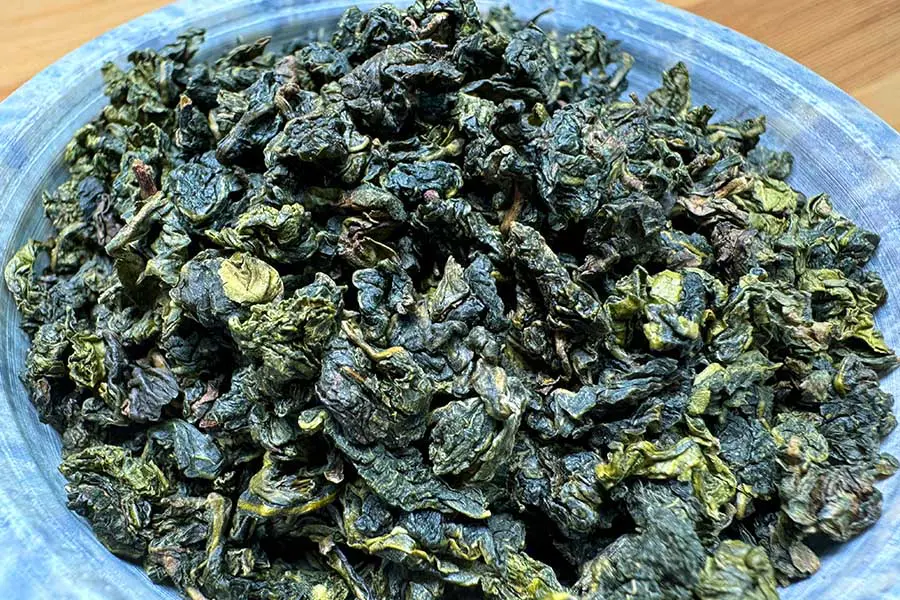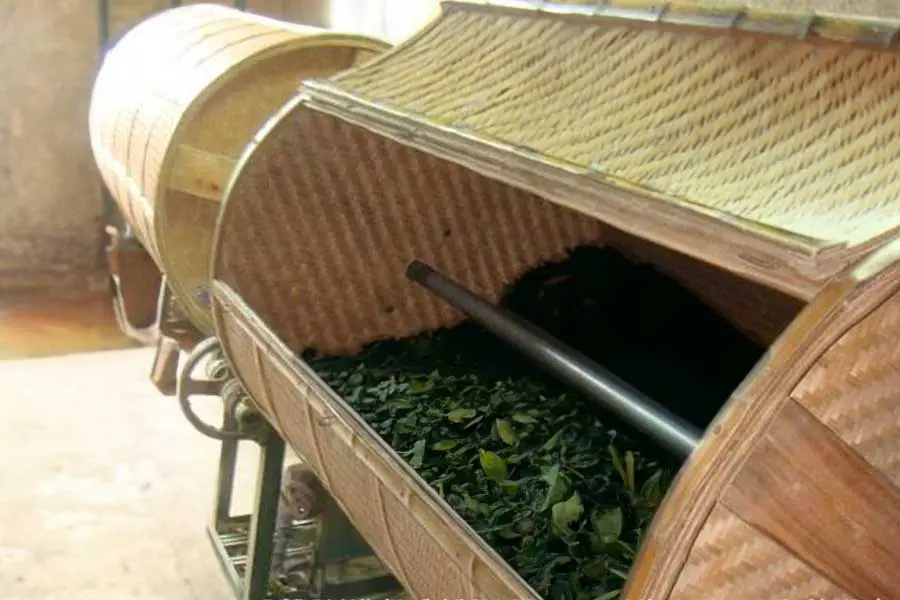Oolong tea, also known as blue tea, is a popular variety considered intermediate between green and black tea in terms of oxidation process. Understanding the production process of this tea is crucial for grasping its distinctive character.
The nickname “blue tea” is due to the bluish tone the leaves acquire during their semi-oxidation process. On the other hand, the word “Oolong” originates from the Fujian dialect, a region where a significant amount of this tea is produced. “Oolong” translates to “black dragon,” possibly because of the twisted shape of the leaves.
Hailing from regions like Taiwan and other parts of China and East Asia, Oolong tea finds its ideal habitat in mountainous environments, where morning mists and mineral-rich soils provide optimal growing conditions.
This tea is renowned for offering a wide range of flavor profiles, ranging from delicate floral notes to more robust, toasted flavors.

Cultivation and Harvesting
It’s essential to highlight the uniqueness of the rocky terrain where this type of tea is typically cultivated. Oolong tea plantations are commonly found in mountainous regions with mineral-rich soils. This rocky terrain gives a unique quality to oolong tea, as the tea plant roots absorb minerals from the earth, resulting in the distinctive flavor and aroma of the final infusion.
Common oolong tea cultivars include Tie Guan Yin in China and Dong Ding in Taiwan. These varieties are prized for their flavor complexity, largely attributed to the unique characteristics of the rocky terrain in which they are grown.

Like other types of tea, the first phase in oolong tea production begins with the harvesting of tea leaves at the optimal stage of maturity. The quality and flavor of the final tea depend largely on the proper selection of leaves in this initial stage.
Solar Withering
Solar withering is the initial phase in oolong tea production, considering this a fundamental stage. Distinguishing it from other tea varieties, withering occurs directly under sunlight. Tea leaves are carefully spread across mesh and mats for hours.
Sun exposure has a dual purpose: gradually extracting moisture from the leaves, and activating natural enzymes that promote oxidation. This deliberate process is essential for capturing the distinct flavors and aromas that define oolong tea.

During solar withering, producers closely monitor the environmental conditions to ensure consistent and high-quality results. However, high temperatures can sometimes pose a challenge, as there is a risk of leaves burning and compromising their flavor.
To mitigate this effect, some producers combine solar withering with a shaded process. They use additional techniques, such as the use of awnings or shading nets, to control temperature and humidity. This allows adjusting the amount of sunlight reaching the leaves, optimizing conditions for the process.
Moreover, the choice of timing for this stage can influence the final flavor profile of the tea, as the intensity and angle of sunlight vary throughout the day. This careful control of solar withering is a good example of the producers’ commitment to quality and excellence in oolong tea production.
Bruising
In oolong tea production, the bruising phase is an artisanal process where tea producers employ traditional techniques and extensive knowledge to mold and transform withered tea leaves.
They use large bamboo or wicker baskets that rotate on their axis. With these tools, producers execute precise and delicate movements to manipulate the leaves, aiming to achieve uniform and consistent oxidation. Additionally, it’s important in this phase to find the right balance between applying force and preserving the integrity of the leaves.

The primary goal of bruising is not only to break the surface cells of the tea leaves to initiate oxidation but also to give them a specific shape uniformly and consistently.
Fixing
After bruising, tea leaves undergo the fixation process through exposure to moderate heat. This halts oxidation and reduces leaf moisture, preparing them for the next stage of the process.
For the production of blue tea, the fixation method typically employed is leaf toasting using machinery, rather than the manual and steam methods.
Rolling
In oolong tea production, there is a combination of the fixation, rolling, and drying stages. After the first roasting, the leaves are meticulously compacted into a cloth ball approximately 20 centimeters in diameter, using rolling machines. Subsequently, these cloth balls undergo a second roasting process at moderate temperatures.

During this phase, individual leaves compress into small pellets, formatting a more compact and uniform structure. These roasting and ball formation steps can be repeated more than 20 times, depending on the producer’s wanted level of detail and dedication.
It is essential to highlight that producing quality oolong tea requires meticulous attention to the process by experienced tea masters. While some less scrupulous factories may opt to produce a large number of balls, letting them rest for hours, true tea lovers prefer to follow the laborious method that guarantees even better results.
Drying
After completing the necessary cycles, the leaves undergo a drying process to eliminate any residual moisture. This step takes place in a controlled environment, where the leaves are exposed to gentle air flow and moderate temperatures. The goal is to ensure that the leaves retain their essential properties without losing the characteristic floral flavor of blue tea and its delicate aromatic notes.
Classification and Packaging
Once the drying phase is completed, the final two steps of oolong tea production involve grading it into different categories based on its quality and characteristics and the packaging.
During grading, producers consider various factors such as leaf size, color, and aroma to determine the appropriate classification. Subsequently, the tea is carefully packaged, often using vacuum sealing techniques to minimize oxidative activity and maintain freshness for longer periods. This process ensures that oolong tea reaches consumers in optimal condition, ready to delight the senses with its floral sweetness and superior aromatic notes.
Re-roasting
Occasionally, buyers opt to take the process a step further by re-roasting the tea.
After completing the production process, if the tea allows for further oxidation without compromising its flavor, it undergoes an additional roasting process to soften the tea’s flavor and impart distinctive characteristics.
Re-roasted teas are particularly appreciated for their versatility and offer an extended shelf life due to their increased stability.
All these phases give us a deep understanding of the dedication and precision required to create this tea variety. Each stage is crucial to ensuring the quality and complexity of this intermediate tea.
As tea professionals, this understanding empowers us to fully grasp and understand the intricate array of flavors and aromas present in oolong tea, offering our customers a truly enriching experience.










